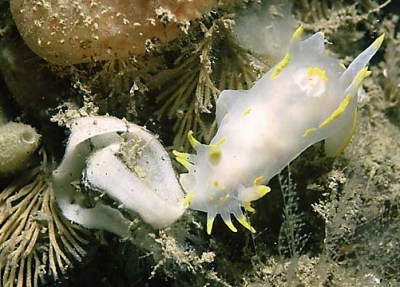
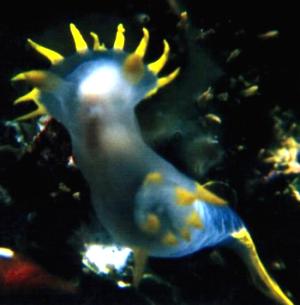
Polycera faeroensis
Lemche, 1929
Order: NUDIBRANCHIA
Suborder: DORIDINA
Superfamily: ANADORIDOIDEA
Family: Polyceridae
Subfamily: Polycerinae
DISTRIBUTION
North-eastern Atlantic at least from southern Spain north to British Isles, Sweden, and the Faeroes.
PHOTO
UPPER: with egg ribbon. Rathlin Island, Northern Ireland. PHOTO: Bernard Picton.
LOWER: Bay of Algeciras (Strait of Gibraltar, Southern Spain) at 21 m. depth, Size: 18 mm. July, 2000 PHOTO: Alma Sánchez.
Animal translucent white with bright yellow papillae around the anterior mantle edge. The papillae near the gills are also yellow, as are the tips of the gills and the rhinophores. There is also a median yellow line from the gills to the tip of the posterior foot. Thompson & Brown (1984) also report that black patches can sometimes be present. They also report that in the British Isles this species feeds on the colonial bryozoans Crisia denticulata, Cellepora pumicosa and Bugula plumosa. It can grow to 45mm in length.
Reference:
• Thompson, T.E. & Brown, G.H. (1984) Biology of Opisthobranch Molluscs, Vol 2. Ray Society: London.
Rudman, W.B., 2001 (February 4) Polycera faeroensis Lemche, 1929. [In] Sea Slug Forum. Australian Museum, Sydney. Available from http://www.seaslugforum.net/find/polyfaer
Related messages
Polycera faeroensis, from Belle-isle, Brittany, France
July 7, 2006
From: Stephane Ores

Dear Bill
I saw this nudi, which seems to be Polycera faeroensis
I'm sorry : I don't have better photo showing the head
Locality: Belle-Isle-en-mer, 12 m, Brittany, France, Channel, Atlantic Ocean, 11 june 2005, Good visibility. Length: 15 mm. Photographer: Stephane Ores.
Stephane Ores
stephane.ores@neuf.fr
Ores, S., 2006 (Jul 7) Polycera faeroensis, from Belle-isle, Brittany, France. [Message in] Sea Slug Forum. Australian Museum, Sydney. Available from http://www.seaslugforum.net/find/16984
Dear Stephane,
I agree with your identification. Although we can't see the head clearly, and so can't see how many tentacles there are on the oral veil, we can see three in just a small section of the left hand side so it is more likely to have 8 or more, as in P. faeroensis, rather than just 4 as in P. quadrilineata. Also in your photo, the right process alongside the gills is flattened and has a bifid tip. In P. faeroensis the lateral process, on either side of the gills, often flattens out even more than this and develops a number of yellow-tipped points along the edge.
Best wishes,
Bill Rudman
Polycera faeroensis immortalised on a stamp
July 28, 2004
From: Arne List

Int the German Wikipedia, I gave Polycera faeroensis the 'common name' "färöische Hörnchenschnecke", because another source calls Polycera quadrilineata "gestreifte Hörnchenschnecke". Faeroensis = from the Faeroes.
The Faroese post published a stamp of it in 2002. This is a real beauty, isn't it? :-)
In the Faroese language it has the name Bertákna. The exact meaning of this word I don't know, but I find in my dictionary the Faroese word tákn, what means in this case: tentacle.
See:
• http://de.wikipedia.org/wiki/F%E4r%F6ische_H%F6rnchenschnecke
• http://www.stamps.fo/default.asp?catalog%5Fname=Frim%E6rker&category%5Fname=Havdyr&product%5Fid=409
Arne List
arne.list@gmx.net
List, A., 2004 (Jul 28) Polycera faeroensis immortalised on a stamp. [Message in] Sea Slug Forum. Australian Museum, Sydney. Available from http://www.seaslugforum.net/find/12661Thanks Arne,
I am not a great supporter of common names but certainly like to see nudibranchs and the relatives on stamps. I support anything that helps to make us more aware of the wonders of nature.
Best wishes
Bill Rudman
Polycera faeroensis from Guernsey - revisited
July 23, 2003
From: Richard Lord
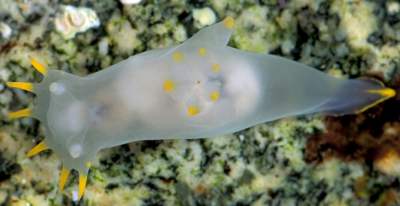
Dear Bill
I received this Polycera from one of Clive Brown's crab pots off the South coast of Guernsey [Channel Ids, UK] on July 10, 2003 [see earlier message]. I believe, based primarily on pigmentation, that it is Polycera faeroensis but I am wondering if it could be Polycera quadrilineata because of the few oral veil processes. Have some been 'bitten off?'
Richard Lord
fishinfo@guernsey.net
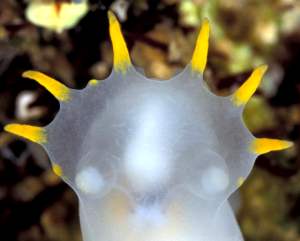
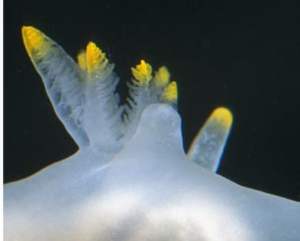
Dear Richard
I'm pretty sure this is P. faeroensis. It lacks yellow spots and has at least 6 mantle 'tentacles' and hints of another three. P. quadrilineata usually has 4. Your animal certainly seems to have sustained some damage. It looks like the rhinophores are regrowing - and the left extrabranchial process.
Best wishes,
Bill Rudman
Polycera faeroensis from Guernsey
July 14, 2003
From: Richard Lord

Dear Bill:
Here is another opisthobranch from crab potter Clive Brown, who works strings of crab pots along Guernsey's south coast (English Channel, Great Britain (about 49 24 N and 002 38 W)). This Polycera faeroensis was collected on June 30, 2003.
Best wishes,
Richard
fishinfo@guernsey.net
Lord, R., 2003 (Jul 14) Polycera faeroensis from Guernsey. [Message in] Sea Slug Forum. Australian Museum, Sydney. Available from http://www.seaslugforum.net/find/10433Thanks Richard,
Bill Rudman
Re: Polycera faeroensis from Brittany, France
June 14, 2003
From: Marina Poddubetskaia

Dear Bill,
Sorry for this late reply, I'm just back from Senegal where I spent 2 weeks diving. It was fabulous: I saw most species photographed by Patrice Petit de Voize some years ago, and even many other species. I have some nice surprises for you in my luggage.
To come back to your comments about Polycera from Brittany. I had a look at my photos and I can't see any bryozoan on it. All animals were photographed on red algae. I will be more attentive the next time.
Best wishes,
Marina.
nembro@nembro.info
Poddubetskaia, M., 2003 (Jun 14) Re: Polycera faeroensis from Brittany, France. [Message in] Sea Slug Forum. Australian Museum, Sydney. Available from http://www.seaslugforum.net/find/10195Dear Marina,
I look forward to the photos from Senegal. Concerning the Polycera from Brittany. I was just alerting you to things worth looking for in future really. Sometimes bryozoan colonies - both the plant-like branching colonies and the encrusting colonies are large and very obvious, but other times the colonies are quite small and by the time the polycerids are big enough for you to notice, they have eaten most of the visible bryozoan colonies. That's probably why we often find groups of large animals in places where there are no obvious bryozoans.
Best wishes,
Bill Rudman
Polycera faeroensis from French Brittany
June 6, 2003
From: Marina Poddubetskaia
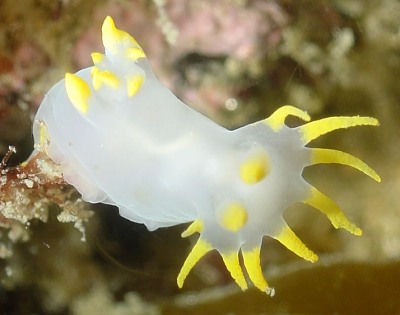
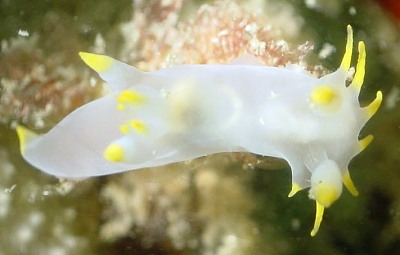
Dear Bill,
I found these Polycera faeroensis in large numbers in Mont Saint-Michel Bay. They were much more numerous than the common Polycera quadrilineata.
Location: Saint-Malo, France, Atlantic coast
Site: Bizeux; Temperature: 12°C; 19 April 2003.
Upper Photo: Depth: 6m; Size: 20-25mm
Lower Photo: Depth: 7m; Size: 15-20mm
Photos: Marina Poddubetskaia - Nembro website
Best wishes,
Marina.
nembro@nembro.info
Poddubetskaia, M., 2003 (Jun 6) Polycera faeroensis from French Brittany. [Message in] Sea Slug Forum. Australian Museum, Sydney. Available from http://www.seaslugforum.net/find/9770Thanks Marina,
Were Polycera quadrilineata and Polycera faeroensis together on the same bryozoans? P. quadrilineata feeds mainly on encrusting bryozoans like Membranipora sp while Picton & Morrow (1994) suggest that P. faeroensis probably feeds on arboresent or erect bryozoans such as Crisia and perhaps Bugula. The presence or absence of their food organisms could explain why one Polycera was more anbundant than the other.
Best wishes,
Bill Rudman
Polycera faeroensis from Northern Ireland
February 8, 2001
From: Bernard Picton
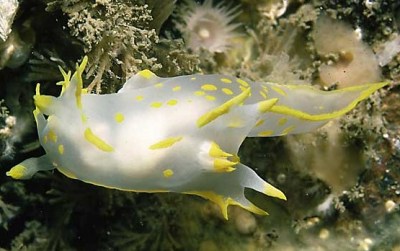

Hi Bill,
Alma Sanchez' record of Polycera faeroensis from the Straits of Gibraltar is the most southerly one I know of but I see it has been found in the Mediterranean before [Erwin Koehler's website]. Alma's pictures show the typical colour form. This is a very common (and conspicuous) species
sublittorally throughout the British Isles. I have records from Brittany, near Santander on the north coast of Spain and Galicia on the NW coast (where cold upwellings occur and many species are in common with the British Isles).
I enclose pictures showing the spotted variety [upper photo] mentioned by Thompson and Brown and an animal with its spawn coil [lower photo]. In my experience the species is normally on Crisia species, but the bryozoan in these photographs is Caberea ellisii. Whether this is being eaten or is just a more robust substratum for egg-laying I can't say. Photographs from Rathlin Island, Northern Ireland.
Bernard
bernard.picton.um@nics.gov.uk
Picton, B., 2001 (Feb 8) Polycera faeroensis from Northern Ireland. [Message in] Sea Slug Forum. Australian Museum, Sydney. Available from http://www.seaslugforum.net/find/3744Thanks Bernard,
Bill Rudman
Polycera faeroensis from Spain
February 5, 2001
From: Alma Sánchez
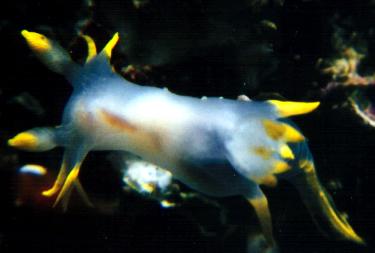

Dear Dr. Rudman,
Here are two photos of Polycera faeroensis Lemche, 1929 from Spain.
This specimen was collected in July, 2000 at the Bay of Algeciras (Strait of Gibraltar, Southern Spain) at 21 m. depth, Size: 18 mm.
Best wishes,
Alma Sánchez.
almasanchez83@hotmail.com
Sanchez, A., 2001 (Feb 5) Polycera faeroensis from Spain. [Message in] Sea Slug Forum. Australian Museum, Sydney. Available from http://www.seaslugforum.net/find/3713Thanks Alma,
Best wishes,
Bill Rudman
